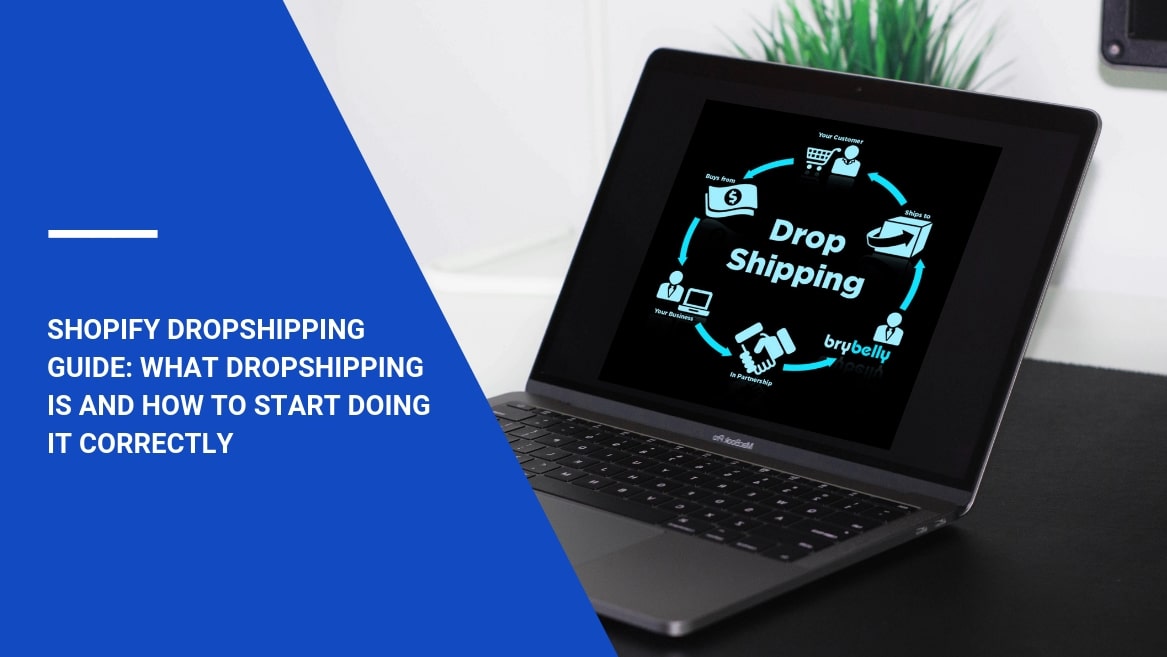
Practically every merchant has heard of the term “dropshipping”. Dropshipping is a business model that lets entrepreneurs sell stuff without dealing with their own inventory and shipment. How does dropshipping work? A seller collaborates with some goods’ supplier and places his products on the seller’s website. As soon as an order is received, the seller hands it over to the supplier, who performs the delivery.
Content:
- How to start a dropshipping business online: creating a dropship store
- How to start a dropshipping business: finding a supplier
- Conclusion

Setting up a dropshipping site and starting this type of business seems reasonable to many merchants as it spares them the additional expenses of the inventory and shipping. Still, this business concept has some cons along with the pros. Let’s figure out the most typical ones.
The benefits of dropshipping
- The simplicity of launch
The dropship model is attractive due to its quick and easy startup: all you need is your own dropship site, a reliable supplier, and off you go. Along with this comes low costs for a business establishment as you spend nothing on your inventory. The only expenses you have are connected with creating and maintaining your website.
- Lower risks
If you fail as a dropshipper, the financial losses won’t be too critical compared to the classical retail business model.
- No need to be tied to a location
Dropshipping can be done from practically everywhere – it’s non-location-dependent. You can work from home and save the money that would have been spent on an office.
- Items flexibility
As a dropship merchant you can sell any type of goods you want. Another advantage of dealing with a third-party supplier is no responsibility for damaged goods, as the shipping is fulfilled by the supplier.
Disadvantages of the dropship model
- Less profit
Product prices in dropshipping can be higher that in an ordinary business model, which can negatively affect your margins.
- Reputation risks
Even if all the responsibility for the quality of goods and their safety during shipment lie with the supplier, annoyed customers will still blame you for any problems. To avoid such situations, you should pick the supplier carefully.
- Competitiveness
Due to the simplicity of running a dropship business, the competition in this niche is extremely high.
- Inventory issues
You won’t be able to trace how things are going at your supplier’s warehouses. If some items are out of stock there and they are marked as in stock on your website there will be additional difficulties.
Despite some cons of dropshipping, this model is perfect for beginners and those who don’t want to spend a fortune on setting up a new business. The profit margins you will get may vary from 15% to 40% (or more if the goods you sell are exclusive or luxury). The main thing is finding the proper supplier.
How to start a dropshipping business online: creating a dropship store
It’s not hard to learn how to do dropshipping, nevertheless there can be a lot of hidden obstacles a merchant should be aware of. But first things first. Any online dropship business starts with opening your own dropship store.

First of all you need to state what kind of website you’d like to launch. For a beginner who wants to reduce costs as much as possible, it would be a good idea to stick to a large marketplace or an eCommerce platform like Shopify. Shopify dropshipping is extremely simple to start and perform. To open up a new store you’ll need about an hour and just a small amount of money.
Setting up a Shopify dropshipping store doesn’t differ from creating any other store on the platform: register, buy a domain or use an existing one, add a theme, add collections and fill out the required fields. You can add various shopping channels to expand your audience – like Amazon, for instance. It’s easy to learn how to dropship on Amazon. First of all, your activities must comply with the terms of policy of the platform. You must not buy goods from other retailers and sell them using their name.
To make your dropshipping on Shopify and Amazon convenient and not too time-consuming, you can use various applications available on the app stores of these resources. There are a lot of tools for integration with the platforms, order tracking, and much more, which will reduce errors and facilitate your business.
Another thing a merchant should learn is how to dropship on eBay – a giant shopping platform with a huge potential. The process of starting here is similar to those for Shopify and Amazon. You must find a supplier, create your account adding the vendor’s data there, add the items you are going to sell, contact data, etc. and you are ready to dropship.
The main advantages of using Shopify or other eCommerce platforms for creating a dropshipping website is the low costs and the simplicity of getting started. Apart from that, having a Shopify account enables you to integrate your webstore with other platforms, enlarge your audience, and thus increase the profit received. Apps for dropshipping facilitate every aspect or running the business, making your actions automated and precise.
How to start a dropshipping business: finding a supplier
As we have mentioned before, launching the dropship store itself is easy, but behind it lies the most important part of the story – picking a supplier. Your vendor is the person on whom your profit and reputation will partially depend, so finding a good one may become a challenging task.
How do you find dropshipping suppliers that will fit your demands? The first thing is where to search for them. Apart from manual Google search, you can use specific Shopify apps where trusted suppliers are listed on scrollable dropshipping directories.

The second and main thing you need is to state what kind of supplier you need. Here is the list of criteria that a trustworthy, punctual and accurate vendor must meet:
- Experience and good staff
A supplier who’ll let you sleep easy must have plenty of experience in the market. Usually self-respecting vendors have a professional team with sales representatives who are always there to help and know every tiny detail about their products.
- Quality
High-quality goods cost more as their manufacture has more expenses. Nevertheless, look for suppliers whose items are quality ones so that your first-time customers will become regular ones.
- Technological resources
When picking a supplier, do not rely on plain promises – make sure they have the ability to fulfill orders on time and receive goods undamaged. Keep in mind that the amount of orders may grow within time, and all of them still need to be delivered with concrete terms.
- Delivery terms
The previous condition implies that the faster your supplier can deliver the items, the happier your potential customers will be. Due to the high competitiveness and the bustle of everyday life, clients will prefer those who will ship them the products today, tomorrow at the latest.
Other important issues you should bear in mind are prices, the chance of them increasing, and the pricing terms. You must figure out whether a supplier has a return policy and a guarantee. Don’t be ashamed to ask about additional costs and profit margins, and make sure there will be a sales rep who can make things clear in case other questions arise. It’s better to prepare a list of questions beforehand, meet up with several suppliers, and find the right one for you knowing exactly what you’d like to sell. Like any business, dropshipping can become a success or a disaster depending on the business decisions you make.
Conclusion
Dropshipping is probably the most cost-effective and simple business for eCommerce merchants, but it must be run properly. In our Shopify dropshipping guide we have covered the most frequent problems a dropshipper may face, along with the benefits of this business model. Pick a reliable supplier, create your Shopify store, add sales channels, and feel free to enjoy your profit.
Super informative article. Great attention to details!
Thank you!
Hey Andrey!
Thought that I’d leave a comment. Thanks for taking your time to write this post and share your knowledge with us.
Thank you, Chris! We are happy to help you learn more about eCommerce business opportunities.